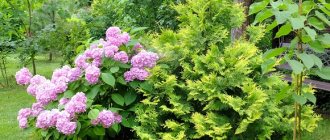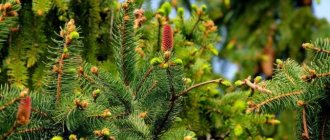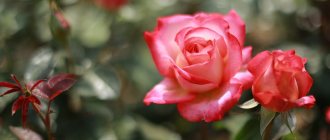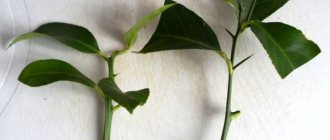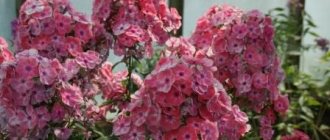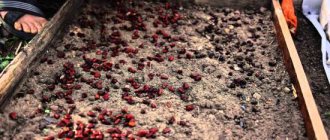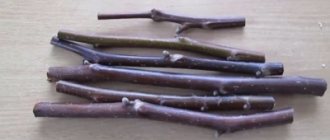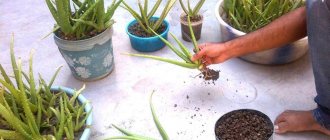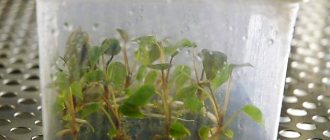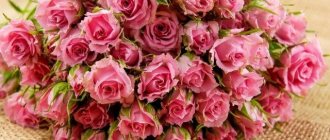Greetings to all readers! It seems to me that without coniferous plants, a suburban area looks somehow wrong, as if something is missing here. And without these plants there is not enough volume in the garden and bright colors in winter.
On my site there are 9 mature spruce trees planted by the previous owners, and there are several more young ones growing that grew naturally - from fallen seeds. My husband and I also planted a fir tree. Today I want to tell you about how to grow fir in the country and what types of fir for the garden generally exist.
Preparing seeds for planting
You can buy planting material in a store, but if you live near a forest, you can save money and go there for seeds. However, in this case it is very important to do everything on time. After all, when the cones open completely, the seeds will fall out and only sticks will remain. Start collecting seeds no later than the beginning of November, as if removing them from the cone, running your hand from the base to the tip. Do not forget to sort out the collected seeds, freeing them from scales.
Don't throw away the scales - they make excellent mulch.
Next, put the dry seeds in a bag and send them for stratification in the refrigerator until spring. In the spring, before sowing, soak them for a day.
Optimal timing of fir cuttings
Preparation of cuttings begins in early spring or already in autumn. You can also carry out the procedure at the beginning or end of summer. The most optimal time for preparing planting material is spring, when active sap flow has not yet begun. For the southern regions this is March; for colder climates you should wait until April. Cuttings are cut in the morning or on a cloudy but not rainy day. You should not do this in direct sunlight. When preparing planting material in the spring, the shoots will take root this year.
It is permissible to carry out cuttings in June, when the plant is developing intensively. But in this case, a full-fledged root system will develop only next year. In the current season, only callus is formed.
Important! Callus is connective tissue that grows around a wound to protect it from external influences.
If time is lost at the beginning of summer, then cuttings can be prepared in August. During this period, they slow down their growth, and lignification begins. Winter cuttings are prepared until November.
When harvesting shoots in summer and spring, they are rooted immediately, and when collected in the fall, they are stored in a cool, ventilated area until the next season. The temperature for cuttings should be maintained at up to + 5 °C. Such conditions can be created by placing planting material in containers and putting them in the refrigerator. Next season it will be possible to grow fir from cuttings.
Fir from seeds - planting methods
Seed cultivation of fir can be done in two ways:
- winter sowing in open ground;
- spring planting seeds in pots.
For spring planting, seed stratification is mandatory - it increases their germination. In autumn, the procedure is significantly simplified, and you can safely sow fir immediately after collecting the seeds.
Features of winter sowing of fir
When sowing in open ground before winter, a place for a fir nursery must be selected and prepared in advance. For the first couple of years, bright sun is contraindicated for young plants, so it is better to sow in partial shade. It is worth worrying about the soil by adding soil for coniferous plants to the garden bed.
It is convenient to plant fir in shallow grooves, scattering them evenly. Sprinkle a thin layer of soil on top. There is no need to deepen the plant so that the sprouts can break through the soil layer. It is advisable to mulch the crops with pine bark. When sown in winter, the seeds undergo natural stratification and will produce more vigorous shoots in the spring.
To prevent cats and other animals from digging up the seedling bed, fence it with netting.
When to sow seeds in spring
Start sowing fir trees in mid-spring, remembering to soak them first. Pour a loose substrate of compost, sawdust and sand into low containers. Scatter the seeds over the surface or into shallow grooves and cover lightly with a layer of soil. Mulch the top with pine litter and cover the container with film. A month later, when the seeds sprout, remove the film and provide good lighting. In the summer, seedlings can be taken outside, placing them under trees.
Replant fir grown from seeds into a permanent place no earlier than 5 years of age.
Growing fir from seeds - video
Most lovers of ornamental gardening strive to decorate their summer cottage with beautiful evergreen trees. This is understandable, since such plantings have an excellent appearance and decorate the garden throughout the entire calendar year. And as a leader, many prefer to plant fir - an incredibly beautiful coniferous tree with soft fluffy needles.
Propagation of fir by cuttings at home
One of the ways to propagate conifers is to harvest and germinate cuttings, as a result of which the varietal characteristics of the tree are preserved. Fir propagates by cuttings without problems if a number of conditions are provided to the seedlings during the growing process.
Is it possible to grow a fir from a branch?
Cuttings are one of the propagation methods that is used for conifers. It is chosen when it is necessary to preserve the decorative properties of wood. When grown from seeds, the tree may lose some external qualities.
Growing a fir from a cutting is a completely solvable task. It is important to choose a healthy parent tree and cut the shoots at the right time. Even if all conditions are met, only 30–40% of cuttings take root.
Advantages of fir propagation by cuttings:
- all the characteristics of the mother plant are preserved;
- no special knowledge or skills are required;
- high endurance of seedlings.
Despite the advantages of the method, cuttings are used less often for fir than for cypress, thuja and other conifers. If it is not possible to obtain cuttings, then choose other methods of propagation: seeds or grafting.
Features of growing fir from cuttings at home
To root a fir from a branch, take into account the following features of this process:
- choose the source tree and its shoots correctly;
- comply with work deadlines;
- prepare the substrate;
- provide the desired microclimate in the room;
- care for rooted plants.
Without treatment, cuttings of Siberian, Korean, subalpine, and myra fir do not take root. Monochrome, graceful, European species take root best. Even after treatment, cuttings of subalpine and Arizona varieties do not produce roots.
Timing of fir cuttings
To grow fir from cuttings, it is important to choose the right timing:
- when spring comes;
- at the beginning of summer;
- at the end of summer;
- in the fall.
The most successful period is the end of winter or spring, when the trees are just beginning to flow sap. In the southern regions this is March, in colder climates it is April. The resulting cuttings root without problems within a year. For work, choose the morning period or a cloudy day.
Is it possible to plant fir on the site?
Fir belongs to the pine family and includes more than 80 species, representing both tall trees and small shrubs. This plant is quite often found growing wild. It can be found in coniferous and mixed forests; it can grow either as individual trees among spruce and pine trees, or in small groups. Planting fir in the country is quite common. These trees do well in many climate zones; they are durable and unpretentious. The technology for growing fir on a personal plot is simple and does not require special knowledge.
Fir in landscape design
The tradition of planting fir trees on personal plots has existed for a long time. In Soviet times, numerous plantings of these trees decorated the territories of sanatoriums, rest homes, scientific institutions, and schoolyards. This is due not only to the decorative component. Fir emits a magnificent pine aroma, and its needles emit a large amount of phytoncides - volatile compounds that disinfect the air. These trees are planted in both single and group plantings, using them as architectural elements, pillars or rows of columns in the design of alleys.
Which fir to plant at a dacha in the Moscow region
The climate of the Moscow region is quite suitable for planting fir. Severe frosts have now become very rare, so the likelihood of trees dying in winter is low. The following types can be used for planting in the Moscow region:
- Balsam fir. Under natural conditions, it lives up to 300 years, growing up to 15 m. There are dwarf varieties (Nano and Piccolo). The needles are up to 2.5 cm long, soft, even. It has a dense, specific pine smell.
- Korean fir. An evergreen coniferous plant with a wide pyramidal crown. Reaches 15 m in height and 2.5 m in diameter. The needles are up to 2 cm, blunt, rich bright green. It has quite a few varieties (Silberlock, Molly, Tundra, Oberon, Green Carpet, etc.), and is widely used in ornamental gardening.
- Siberian fir. Under natural conditions, it lives up to 200 years, reaching a height of 50–60, and in some cases 100 m; the trunk diameter can reach 2.5 m. The crown is cone-shaped and narrow. The needles are up to 3 cm long, soft, with blunt tips. Has a subtle pine aroma.
- Great fir. Found in the wild in North America. The tree grows up to 35-50 m, sometimes up to 70 m, the trunk diameter is up to 1.5 m. The crown is pyramidal, becoming round in an adult tree. The needles are soft, up to 5.5 cm long, bright green with a white stripe below. Lives up to 200–250 years.
- Whole-leaved fir. It grows up to 30 m by the age of 100, and at a more mature age – up to 55 m. The crown is wide, conical. The needles are up to 4 cm long, light green, flat.
Fir: description of a coniferous plant
The homeland of this evergreen plant is the Caucasus and North America. The variety of tree varieties has made it a favorite of many gardeners. If a fir grows in the wild, its height can reach eight meters; the growth of ornamental species rarely exceeds two meters.
The fir trunk is covered with hard bark with small cracks or generally smooth (this depends on the variety), the root is taprooted, but very powerful, which allows it to go to a sufficient depth. The needles of this tree are flat, soft, and arranged spirally on the shoot (in some varieties, comb-shaped).
Fir grown in pots (the description of its care will be discussed later) differs from street fir in the color of its needles and the shape of its crown. Fir is mainly grown at home:
- Nordman (or Caucasian);
- Fraser;
- erect;
- golden;
- blue.
Decorative varieties of fir can live for several centuries, and in the wild - about 800 years. Moreover, a tree planted in open ground grows 30 cm per year, while in a pot it can only grow 4-6 cm per year.
Fir is unpretentious in planting and further care, so many summer residents plant it in their garden plots. During flowering, male (earring-like) and female (cones growing upward) flowers appear on the fir. They are wind pollinated and produce mature seeds the same year.
How to plant fir on the site
Planting a fir is no more difficult than any other tree. For planting, seedlings that have reached the age of 4 years are used. They can be purchased in specialized stores or nurseries. Photos of fir seedlings below:
Landing dates
The best time to plant fir in a permanent place in the garden is April. If deadlines are missed, do not rush. You can also plant fir at the end of August or beginning of September. The technology for planting fir in autumn is no different from spring. However, later dates are undesirable, since the seedlings may not have time to acclimatize to the new place and will die from frost. Planting fir in open ground in winter is possible only in the southern regions, where there are no negative temperatures.
Where to plant fir on the site
Shady or semi-shaded areas are suitable for planting fir. The soil is preferably loamy, loose and fertile, moderately moist. It is recommended to plant these trees a short distance from natural bodies of water. Fir can also be planted near the house, but it is also necessary to take into account the dimensions of the future tree, as well as the fact that it will provide significant shade.
Preparing the landing site
To plant fir correctly, holes for future trees must be prepared in advance, preferably 2-4 weeks before the expected planting date. Their size depends on the size of the container in which the seedling grows, since planting is carried out together with a lump of earth on the roots. Usually a hole of 0.6 m in diameter and the same depth is quite sufficient. Drainage made of coarse crushed stone, expanded clay or broken brick should be laid at the bottom. Then the hole is filled halfway with a soil mixture consisting of river sand, peat, humus and turf soil, taken in a ratio of 1:1:2:2. Additionally, you can acidify the soil using clay or sawdust.
After preparing the soil, the hole for planting fir is spilled with 2-3 buckets of water and left for 10-14 days. During this time, the soil will have time to settle and become saturated with nutrients.
Fir seedling planting technology
Before planting, the container with the seedling should be spilled generously with water. This will allow you to easily remove the plant along with a lump of earth. After this, it is installed in the planting hole strictly vertically and covered with nutrient soil, lightly compacting it. In this case, the root collar should be slightly above ground level. The planted plants are watered abundantly, after which the soil is mulched with humus.
When planting fir in the ground in a permanent place, it is necessary to take into account the dimensions of future trees. To prevent them from competing with each other, it is necessary to observe certain intervals when planting. When designing alleys, the distance between neighboring seedlings is 4-5 m, for group plantings - from 2 to 4.5 m, depending on the desired density.
How to replant a fir
Fir, especially at a young age, tolerates transplantation calmly if all necessary measures are followed. The tree is replanted at the same time, in April or early September. Fir can only be replanted with a closed root system. To prepare the plant for replanting, a year before the planned event, the ground around the trunk is bayoneted with a shovel at a distance of 25-30 cm from the trunk; for older trees, this distance must be increased to 50-60 cm. Over the course of the year, the tree will grow a large volume of adventitious roots to replace the chopped off ones. and will endure the transplant calmly. A year later, the tree is dug up and removed along with a lump of earth.
You can transfer it to a new place on a piece of tarpaulin or other dense fabric. It is advisable not to do this alone, since a tree with an earthen lump can have significant weight.
Preparation of the planting hole and planting are carried out in the same sequence as for a young seedling.
Where is the best place to plant
Fir is a drought-resistant crop that loves the sun, so it should be planted in a well-lit place or in light partial shade. The planting hole must be made 20 cm wider and 30 cm deeper than the pot in which the seedling grows. Fir loves loose, nutritious soil. It is advisable to fill in the prepared soil mixture from:
Pour drainage (expanded clay) into the bottom of the hole, then a little soil and 100 g of nitroammophoska. Be sure to mix the fertilizers with the soil and only then will it be possible to install the seedling without deepening the root collar. Fill the voids with nutritious soil, compact and water generously. You can pour directly on the needles, but if you put your hand up, fir loves a shower.
Related article: Araucaria Bidwilla description and features
Is it possible to plant a felled fir?
Felled coniferous trees can stand in water or wet sand for quite a long time. At the same time, the plant often begins to produce fresh needles, and young cones appear on it. Many consider this behavior of the tree to be proof that, under certain conditions, it is possible to grow a full-fledged root system on a felled fir and then plant it in open ground.
However, it is not. It is still not possible to bring a felled fir back to life. Coniferous trees take cuttings rather poorly, and even small branches with a heel cannot always be rooted. An adult fir tree, after being cut down, is guaranteed to die, which can only be delayed by constantly replenishing it with water.
Growing fir in a pot will give you pleasure and delight you with the results
Growing fir in a pot is very fashionable today.
An evergreen coniferous tree with a pleasant aroma can be kept in an apartment or country house and used instead of a Christmas tree. At home it does not grow as quickly as outside. Fir in a pot grows by about 5 cm every year. It looks great both in a living space and in an office. For home keeping, it is necessary to choose dwarf specimens. It is better if these are frost-resistant varieties, then the tree can be kept on the balcony. But it should not be completely open, because the earthen ball and roots freeze faster in the container than in open ground. We must not forget about this.
How to care for fir
Caring for fir is not particularly difficult. The tree is quite unpretentious and, as a rule, does not cause any trouble to the gardener. The only exceptions are decorative species, which require constant care.
How to water a fir
Fir does not require watering. For most species of this tree, artificial irrigation is not only not required, but is also contraindicated, since excess moisture has an extremely negative effect on it. The only exception is moisture-loving species, such as, for example, balsam fir, which must be moderately watered several times during the summer and only during prolonged drought. For other species, precipitation is sufficient.
How to feed
Nutrients added during planting are usually sufficient for the first few years of the fir's life. In the future, fertilizing is carried out once a year, in the spring. 0.1-0.15 g of Kemira-Universal complex fertilizer is usually added to the tree trunk circle, combining this procedure with cleaning and loosening the soil.
Loosening and mulching
Caring for the root zone of fir after planting is one of the mandatory procedures that must be carried out constantly. It is very important to keep tree trunks clean; this significantly reduces the likelihood of diseases and pests appearing on plants. Loosening should be carried out after each rain or watering, while removing weeds. Peat, humus, tree bark or wood chips can be used as mulch, spreading it in a layer of 8-10 cm.
Growing fir in a pot: watering and fertilizing
After replanting the plant, the soil must be well moistened. You can simply place the pot in a bowl of water for 1-2 hours, and then let it drain through the holes at the bottom. Water the fir tree as the soil dries so that water does not accumulate in the pan, otherwise its roots will begin to rot. But you can’t overdry the earthen ball: the tree will grow slowly, the color of the needles will be pale. Water must be poured at the very base of the fir trunk.
It is beneficial to spray the tree a couple of times a week. Periodically wash it in the shower to remove dust. To prevent moisture from evaporating so quickly, the surface of the earth can be sprinkled with a small layer of sawdust or pine needle mulch.
Approximately 2 weeks after replanting, the plant must be fertilized. Specially for coniferous crops, fertilizer is produced in the form of granules. Young plants are rarely fertilized: until the age of two, fir does not need to be fed at all, but then it will slowly increase in growth and will be more susceptible to diseases.
Fir propagation
You can grow fir yourself from seeds or by propagating it by cuttings. This is a rather lengthy process, so a gardener who decides to take such a step should be patient for several years to come.
How to grow fir from seeds
Growing fir from seeds at home is a rather long and labor-intensive process. Difficulties arise already at the stage of seed procurement, since the ripened cones are located on the upper part of the tree. In addition, fir seeds are light and volatile; they quickly fall out and are carried by the wind. Therefore, they are prepared as follows. Unripe cones with closed scales are picked from the tree and placed in a warm place. After the cones ripen and open, the seeds are poured out of them.
After collecting a sufficient number of seeds, they are subjected to stratification. It can be carried out either at home, by placing the planting material in the refrigerator, or outside, simply by burying a container with seeds in the snow. They need to stay in such conditions for about 120 days. Stratified fir seeds are planted in April in special containers filled with a mixture of sand, peat and turf soil. The planting depth should not exceed 1-2 cm. The containers are covered with plastic film, simulating greenhouse conditions.
Periodically, the containers are ventilated, and the soil is moistened and gently loosened. After 3-4 weeks, the first shoots should appear. A year later, they are picked into separate containers and kept for growing up to the age of 4 years. Only after this, young fir trees are planted in permanent places in the spring.
How to propagate by cuttings
Fir can also be propagated vegetatively. Annual shoots 5-8 cm long with one apical bud are used as cuttings. Often they are not cut, but torn off, leaving a heel on the cutting - part of an old woody shoot. Cuttings are taken in the spring, using shoots growing from the north side of the tree in its middle part. It is advisable to do this in cloudy weather. Before planting, harvested cuttings are disinfected by keeping them in a weak solution of potassium permanganate for 5-6 hours. Then they are planted in containers with nutritious soil consisting of humus, sand and turf soil, taken in equal proportions.
The planted cuttings are placed under film or glass. It is necessary to regularly ventilate them, as well as moisten the soil substrate. Rooting fir cuttings is a rather lengthy process. It takes about a year for the cuttings to develop their own roots. A full-fledged root system will be formed only in the 2nd year.
Some nuances of fir propagation are on video:
Other types of fir with photos and descriptions
Fir trees of eastern origin are also of great interest - from Korea, Northern China, and the Far East.
Korean fir in adulthood seems too bulky for a small garden, but, nevertheless, it is quite suitable for such use. It will take many years before this plant reaches 2-4 m in height. It grows slowly. It often happens that the crown diameter of an old Korean fir is greater than the height of the entire plant.
Korean fir
Korean fir
Pay attention to the photo - this type of fir has very beautiful, dense, lush green needles on top and white below, and most importantly, attractive purple cones that appear even on a young tree.
Dwarf fir "Silberlock" in the photo
This species has a dwarf form "Silberlock" . The plant reaches only 80 cm in height - small dark green needles with white undersides. The cones are dark red in color, 10 cm long, and scatter seeds when ripe. Winter hardiness down to -29 °C.
Vicha fir in the photo
Vicha fir is native to Japan. It is very unusual and decorative with its flowing branches with soft, curved needles. At a young age it grows quickly. Winter-hardy and resistant to smoke, smog, and gases. But he loves light and fertile soil.
Equal scale fir in the photo
Equal scale fir is also from Japan. The tree naturally grows in the mountains. Unlike Vicha, it has resinous buds. In Russia it grows successfully on the Black Sea coast, but in the European part it loses all its majesty, reaching a height of 20-25 m.
Fir like bonsai
As shown in the photo, this type of fir in Japan is often cultivated as bonsai, and in its natural form it decorates parks, temples, and castles.
Vetkhova fir in the photo
Vetkhova fir is a tall species, a slender tree reaching 20 m in height and 4 m in crown diameter. It has thick, shiny, dark green needles with a silvery tint on the underside. Every year this tree grows approximately 70 cm in height and 20 cm in width. It is planted mainly singly in large gardens.
Tall or giant fir in the photo
Tall or giant is a species from North America, found in the mountains at an altitude of 2100 m above sea level, where it reaches a height of up to 100 m. Of course, in Europe it does not grow so tall, but it grows successfully, being unpretentious.
Pretty fir in the photo
The pretty fir is also a powerful tree. Grows wild in North America. Its distinctive feature is its long (up to 3 cm) needles with the scent of orange. The buds and young branches are resinous.
Fir trees were a decoration of gardens in Ancient Greece. There are several Mediterranean species known to be of historical interest.
Pretty fir, “Spread Star” form in the photo
A pretty fir, “Spread Star” form - a tree up to 90 cm in height, with low-growing spreading branches.
Look at the photo - this variety of fir eventually forms a carpet 3-3.5 m wide:
Fir forms a carpet over time
Grows best in acidic soil and full sun. Winter-hardy down to -23 °C. It is better to plant in autumn or winter.
Greek fir in the photo
Greek (Parnassian) fir , according to legend, was used to build the Trojan horse. Its peculiarity is the spiral arrangement of the needles. It grows in the mountains of Greece. We feel good in Sochi.
Spanish fir in the photo
Spanish fir is found in the calcareous mountains of Southern Spain at an altitude of 2000 m above sea level. This is a relatively short tree, up to 25 m, very beautiful with its thick crown.
As you can see in the photo, this fir tree has short needles, but thick and hard, which is not typical for other fir trees:
Greek fir in the photo
They are arranged in a spiral, which is why there are no gaps in the crown. The species is thermophilic, not frost-resistant, and undemanding to soils. It is used in landscaping on the Black Sea coast and in Crimea.
Fraser fir
Fraser fir
Fraser fir is an alien from North America, a very stable and decorative species. The tree is low and slender. The needles are short, the buds are resinous. The species is winter-hardy and drought-resistant, but does not tolerate urban conditions.
Subalpine fir in the photo
Subalpine fir is promising for central Russia and the Black Earth Region. It grows wild in Alaska, where it lives high in the mountains. The tree grows very slowly, reaching 20 m in height by the age of 200 years. The buds are resinous, the needles are relatively long, up to 4 cm. The species is unpretentious in cultivation.
Subalpine fir, dwarf form
There is a dwarf form - “Compacta” , which is used when grown in containers.
Sakhalin fir
Sakhalin fir
Sakhalin fir is found in the south of Sakhalin and the Kuril Islands on wooded mountains. It is used in landscaping in the middle latitudes of Russia. The tree is very decorative. Regular conical shape, smooth bark, soft blunt needles - these are the main parameters of its appearance. Produces seeds well. The cones are ellipsoid, up to 7 cm in length. The seeds are yellow or brown with a purple wing. It is moisture-loving, frost-resistant, although the needles freeze slightly during spring frosts, and is unpretentious in cultivation.
Diseases and pests
If you follow all the rules for caring for fir, diseases and pests appear on it quite rarely. Problems are possible only under unfavorable weather conditions, as well as violation of planting rules or poor ecology. The most common diseases that affect these trees are the following.
- Brown swarm of fir. A fungal disease manifests itself in yellowing of the needles, which subsequently turn black. The needles stick together, but do not fall off for a long time. In autumn, the rounded black fruiting bodies of the fungus are clearly visible on them. As a preventive measure, it is recommended to prevent thickening of plantings and waterlogging; you should also pay attention to the quality of planting material. When a disease appears, it is necessary to cull and treat neighboring plantings with biological products or fungicides.
- Fusarium. Caused by soil fungi. It occurs when there is excess moisture and trees are planted on heavy, poorly drained and clayey soils. The disease begins with damage to the roots and then penetrates all tissues of the tree, which gradually turns yellow from below. When a disease occurs, the infected tree is destroyed, and the soil and neighboring plantings are treated with fungicides.
- Rust. A fungal disease that especially often affects young plantings. It appears in the summer in the form of a yellow or orange coating on the branches and greatly weakens the trees. To prevent the appearance, young plantings should be treated with copper sulfate or Bordeaux mixture, and the plantings should not be allowed to thicken.
Among insect pests, several groups are traditionally distinguished:
- Sucking (hermes aphids, false scale insects, spider mites).
- Needle-eaters (fir moth, pine moth, fir moth).
- Damaging cones (cone moth).
- Root pests (wireworms, beetles).
- Stem pests (black fir longhorned beetle, typhoid bark beetle).
Insect pests are controlled by treating plantings with biological products, as well as various insecticides, acaricides and other means. Spraying fir trees with various infusions (tobacco, garlic, dandelion) is also widely practiced.
Growing fir as a business
The constant demand for decorative coniferous trees allows us to consider growing fir in the country as a way to earn money. However, fir can be used not only as an element of landscape design. Fir brooms are very much appreciated by lovers of bath procedures. Infusions and oils are obtained from the needles of this tree, which are used in the treatment of many diseases and are an excellent preventive measure. Camphor is obtained from fir - a substance widely used to treat infections of the respiratory tract, lymph nodes and other diseases.
Fir wood is not inferior in quality to pine or spruce. Therefore, it can be used in construction, as well as for the manufacture of various wooden fittings, decorative elements, carpentry, and furniture.
Seed preparation
As soon as the cones begin to ripen, you can take time to prepare seed material. The cones are collected, dried and the seeds are removed. The germination process begins in March. The first stage is stratification of the seed material. First, the seeds are kept for half an hour in a solution of potassium permanganate for disinfection. Then they are washed and soaked for a day. The seed swells, it is placed in a humid environment (wet sand will do) and placed in the refrigerator for a month. This preparation of seeds is a kind of imitation of natural conditions, increasing and accelerating their germination. This procedure is especially important when there is a limited number of fir seeds. If there is more than enough seed material, you can skip stratification.
Germination of seed
From about the second week of April you can start planting seeds. The soil should be sandy loam and loose.
- a two-centimeter layer of pine sawdust is poured into a container with soil;
- seeds are laid on the sawdust and also sprinkled with sawdust (a layer approximately 1-1.5 cm thick);
- if there is no coniferous material, you can simply bury the seeds in a damp sand-turf mixture. A depth of two centimeters is sufficient;
- The container is covered with film or glass and placed in a warm place, protected from direct sunlight.
The first shoots appear in about a month. The covering material is removed and the container is transferred to a lighted room. Since fir prefers moderately moist soil, regular watering and loosening of the soil is required. In the first year, the fir grows by about 3-4 cm.
Unpretentious beauty fir. Planting and propagation of fir
A cute fir coniferous tree with cones growing vertically on its legs, similar to New Year's toys, is a real decoration of the site, especially on the eve of the winter holidays.
The cones ripen in the year of fir flowering. And it occurs once every 1-3 years (depending on the age of the plant and the species). In autumn or winter, the fruits open, releasing the seeds-nuts. You can collect them and try to grow new firs.
Fir from seeds
Fir seeds need to be stratified for at least 30-40 days. You can place them in damp sand or put them in a plastic bag and leave them in the cold. It is preferable to sow in spring. Dry seeds need to be soaked the day before. Substrate - compost, sand, rotted sawdust (3:1:0.5). Crops can be mulched with fir litter to maintain moisture. If sufficient humidity is maintained, sprouts begin to appear in 7-10 days. In the first 10 years of life, fir trees grow very slowly. It is better to replant them in open ground at 4-5 years of age.
Transplanting seedlings
Seedlings no younger than 4 years old are planted in open ground. To make the plant easier to tolerate planting, it is recommended to carry out the procedure in the fall. A rainy/cloudy day is ideal. A suitable place for growing fir is shade/partial shade, with well-drained soil.
Planting stages:
- In about 10-14 days, a hole for the seedling is prepared. The approximate dimensions of the recess are 60x60x60 cm. More precisely, the dimensions depend on the size of the fir root system. A drainage layer up to 6 cm thick is laid on the bottom (crushed stone and broken brick will do). Half of the hole is filled with soil mixture. Recommended composition: humus, clay, peat, sand (in the ratio 3:2:1:1). Sawdust (10 kg) and nitrophoska (about 30 g) are also added.
- A seedling is planted, and its root collar should be located at the level of the surface of the site.
- The roots of the tree are straightened and the entire hole is filled with the prepared soil mixture.
- The tree is watered.
If you plan to plant more than one seedling (at least an alley), then it is better to immediately adhere to the correct planting scheme. The standard distance between seedlings is 4-5 m. But these requirements may vary, depending on the type of fir. Trees with dense branches can be spaced about 2.5 m apart. And more spreading firs are planted in increments of 3-3.5 m.
Features of planting fir in a room
Fir in a container looks very impressive, but its cultivation requires compliance with a number of rules.
To make fir care more convenient, it is better to use a pot stand on wheels - this way an adult tree can be easily moved around the room.
Lighting, humidity and temperature
If the seedling was purchased in winter, then before planting the fir in a permanent pot, it needs to be given time to get used to the new conditions. At first, the conditions should not differ from those in the store - at a lower temperature than in the room.
As soon as the tree adapts to its environment, move it to the place where you plan to leave it in the future. You need to take care of a good tray and drainage from the beginning - fir loves moist soil, but does not tolerate stagnant moisture (its roots simply rot).
Article on the topic: Oak rock description and features
Any air is suitable for normal growth of fir. There is absolutely no need to take any measures aimed at moistening the fir habitat.
How to choose a container for planting fir
The purchased tree can be immediately planted in a larger (5-10 liters) pot with suitable soil, without destroying the earthen ball around the roots. It is preferable to grow fir in a large pot because they are more stable, hold more soil and, accordingly, the soil in them remains moist longer.
But dwarf fir needs to be replanted into larger pots every 2-3 years. The ideal time for transplantation is September-October. In order for the fir to take root in a new place, there is no need to remove soil from the roots, and the soil after replanting should be fertilized with preparations.
Preparing the soil for planting fir
The main thing you need to take care of is the correct choice of soil. The soil should be nutritious and neutral (possibly slightly alkaline).
Under natural conditions, fir propagation occurs by seeds, so it is better to take light soils, loams, ready-made soil for coniferous plants or a special mixture (clay, peat, sand, leaf soil) as a basis.
To maintain normal nutrition, complex fertilizers are added when planting. In this case, you need to ensure that the root collar of the fir is at soil level.
How to grow fir from cuttings
With this method of propagation, annual shoots up to 10 cm long, with an apical bud and heel, are harvested. The best option is to cut a young seedling (4-7 years old) from the upper part of the crown. Similar operations are carried out at different times of the year (in April, June, August and September-October).
The soil mixture for fir cuttings is also specially prepared. To do this, mix equal parts of sand, earth, and humus. The cuttings are buried at a distance of 8-10 cm from each other. The containers are placed in a warm place, protected from direct sunlight. You should carefully monitor soil moisture. Drying out of the soil is not allowed, but stagnation of moisture is also not encouraged.
Young cuttings taken in spring or early summer can be immediately planted in the ground. And it is advisable to plant the more woody ones, picked in the fall, in the spring.
How to propagate fir
Gardeners usually obtain seedlings of this evergreen tree in two ways:
- cuttings;
- seeds.
Cuttings are better suited for decorative forms of fir created by breeders, and propagation by seeds is better suited for species varieties.
Features of propagation by cuttings
Cuttings are cut from annual shoots of a tree with an upper bud, 10-20 cm long. This should be done at the end of April, June, August or September - November. Spring and summer branches are planted immediately, and the rest are stored in a cool room with high humidity. You can place them in a container and put them in the refrigerator until spring.
How to grow fir from seeds
The first thing you need to do when growing fir from seeds at home is to obtain planting material. You can buy it in a store or get it yourself. In the second case, the procedure must be taken seriously. Seeds should be collected in late October - early November, only from two-year-old cones with gray wings. After collection, they are sorted and prepared, and then planted.
The seeds do not have to be planted right away; you can wait until spring to do this.
How to germinate fir seeds
It is advisable to sow the seeds extracted from the cones in the spring and keep them in a cool, dry place in winter. If you plant fir seeds before winter, they should be germinated. To do this, immediately after collection, the material is sorted and cleaned of all excess, and then placed in the ground and put in the refrigerator. A month before planting in the ground, the seeds are soaked for 30 minutes. in a solution of potassium permanganate, washed, put away together with damp soil in a fabric bag, and again put in the refrigerator or buried in the snow.
How to plant fir from seeds
It is best to plant tree seeds at the end of March, in loose sandy loam soil on top of the first layer of sawdust, then cover it and cover it a second time, watering it abundantly. Cover the container with film and place it in a place protected from direct sunlight. Every day, open the greenhouse briefly for ventilation and spray it with water as it dries. After the shoots appear, remove the film.
Advice! It is advisable to water the seedlings three times during the summer with mineral fertilizers.
How to grow fir at home
You can grow fir at home in a pot. Dwarf varieties are ideal for this. The tree can be purchased, obtained from seeds or propagated vegetatively. Before transplanting into a pot, purchased seedlings should be given time to adapt to the conditions; the seeds are immediately planted in a permanent place. Before the procedure, you should initially take care of the soil nutrition and good drainage.
With proper care, a tree can live for more than a century even at home.
How to care for seedlings
At first, be sure to regularly remove weeds and loosen the soil (sufficient depth - 10-15 cm). It is recommended to mulch the tree trunk circle of seedlings (diameter approximately 0.4-0.5 m). Peat and sawdust can be used as mulch, but the root collar of the tree should not be tightly covered. Acceptable layer thickness is 5-7 cm.
You can feed young trees after 2-3 years. To do this, add up to 125 g of Kemira-universal fertilizer to the tree trunk circle.
Depending on the type of fir, the watering regime is applied. Moisture-loving trees (balsam fir) require 2-3 waterings per season. Moreover, at least 15 liters of water are poured at a time. Other varieties are more tolerant of droughts - natural precipitation is enough for them.
Fir: cultivation and care
In order for the planted fir to feel good, develop and always delight with the rich color of its green needles, you need to pay attention to it.
Growing an evergreen beauty involves following these rules:
- Immediately after planting and the first watering, mulch the tree trunk circle with peat, pine chips or small spruce branches. Mulch will prevent the soil from drying out.
- Install a support and tie the stem of the young plant so that the wind does not break it.
- Water regularly, about once a week, adding 1 bucket of water.
- If mineral fertilizers were added to the hole during planting, the fir does not need to be fed for the first 2-3 years. In the future, you can add humus or compost to the tree trunk circle once a year in the spring. It would also be a good idea to feed the growing fir with minerals once a season, in spring or early autumn. The same nitroammophoska (30 g per 1 sq. m) will do.
Despite being drought-resistant and light-loving, young firs are afraid of burns. Therefore, in the spring it is advisable to build a shelter for them, otherwise the needles may turn yellow and fall off.
Regarding pruning, the fir forms itself and does not need pruning. The only thing is that after wintering, you may need to cut off broken or diseased branches. Thus, growing and caring for fir is not a particularly troublesome task, but pleasant. Having bought and planted a seedling, in a couple of years you will get a small tree with a beautiful bright crown of fluffy needles.
How to plant and care for fir - video
Tree replanting
As a rule, fir seedlings easily take root in new places. But sometimes plans for the location of trees can change. Moving the seedling to another place is not difficult.
If the tree is young, then you just need to use a shovel to mark a circle around it with a diameter of 60-70 cm. The tree is carefully dug up and, together with a lump of earth, is transferred to another hole.
Older firs need preliminary preparation. About a year before transplanting, a wide circle with a diameter of 1.0-1.2 m is marked around the trunk. The soil must be pierced with a shovel to a depth of 25-30 cm. During this period of time, new young roots grow inside the intended circle of the tree. When transplanting, the fir is carefully dug out of the ground and transferred to a new area. It is very important that a lump of soil is preserved and the root system is minimally damaged.
When using the seed method, it must be taken into account that the seedling will grow very slowly. Literally 10-15 cm per year. This is quite natural, since trees spend most of their energy on developing the root system. But as it grows older, the growth of the fir will accelerate.
Choosing a pot
Drainage in a pot with fir is required. When the earthen clod becomes waterlogged and water stagnates, its roots rot very quickly. To grow fir in a pot, it should be taken into account that the new container should be 5-10 liters larger than the original one. Together with the earthen lump, the seedling is simply transferred to a new container and the required amount of soil is added.
A large pot has a number of advantages:
- the wood in it is more stable;
- the soil remains moist for quite a long time;
- There is no need to replant the plant frequently; it is enough to change the pot every 3 years.
The most favorable period for replanting fir is September or October.
Article on the topic: Acacia whorled description and features
